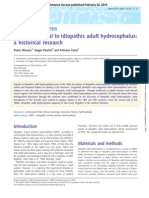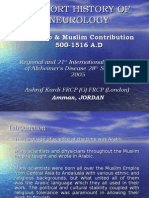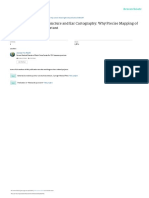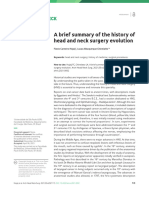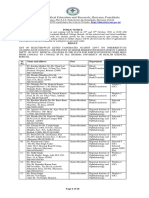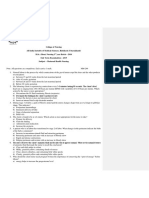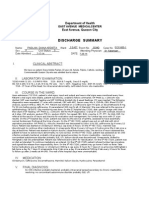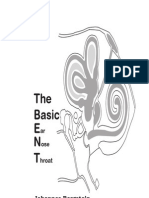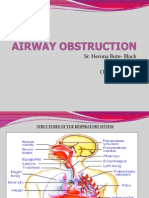The Ear, Nose and Throat in Islamic Medicine: Prof. Dr. Mostafa SHEHATA
The Ear, Nose and Throat in Islamic Medicine: Prof. Dr. Mostafa SHEHATA
Uploaded by
StudentCopyright:
Available Formats
The Ear, Nose and Throat in Islamic Medicine: Prof. Dr. Mostafa SHEHATA
The Ear, Nose and Throat in Islamic Medicine: Prof. Dr. Mostafa SHEHATA
Uploaded by
StudentOriginal Description:
Original Title
Copyright
Available Formats
Share this document
Did you find this document useful?
Is this content inappropriate?
Copyright:
Available Formats
The Ear, Nose and Throat in Islamic Medicine: Prof. Dr. Mostafa SHEHATA
The Ear, Nose and Throat in Islamic Medicine: Prof. Dr. Mostafa SHEHATA
Uploaded by
StudentCopyright:
Available Formats
The Ear, Nose and Throat in Islamic Medicine
Prof. Dr. Mostafa SHEHATA*
* Faculty of Medicine, Alexandria, Egypt
Summary
In this article, The treatments of ear, nose and throat diseases are pointed out in the Islamic world and the books of various Islamic
authors on this topic are stressed.
Key Words: Islamic Medicine, History of Medicine, Middle Ages
It is a good practice to unroll the pages of the past
to discover the successive steps by which the existing
state of things has been brought. This statement is
confirmed by Charles Cumston (1926) who said
that we can never be in fully possession of a science
until we know the history of its development (1).
The Islamic civilization started at the seventh century and progressed rapidly in a relatively short time.
The Quran- the holy book of moslims- mentioned the ears and the sense of hearing several times
and stressed its importance for learning, understanding and the development of mental capabilities (2).
It also mentioned the larynx and the respiratory distress that may be fatal in cases of severe exhaustion (2).
The nose, mouth, face and ears received good
hygienic care, as they should be washed several times
daily in the process of ablution before the regular
prayers.
There are several sayings by Prophet Mohammed
to care about the ear, nose and throat and to use medications for their troubles. In this respect he encouraged the use of local antiseptics, the hot and cold
fomentations and the occasional use of venisection,
cupping and thermocautery (3).
During the subsequent centuries at the time of the
Omayads and Abbasids dynasties, nearly more than
one thousand eminent physicians led the progress of
medicine in the main capitals of the Islamic world,
Baghdad, Damascus, Cairo, Alexandria, Kairouan,
Cordoba, Seville and Valencia.
2
The ear, nose and throat diseases and their management were taken care of by the general physicians, the surgeons and pediatricians.
By their good thinking and high skilful medical
practice, they added new discoveries, inventions and
information to the anatomy and physiology of the ear,
nose and throat. They discovered new diseases and
new lines of medical and surgical treatment. All that
have documented in several large medical books of
their own work, that remained the essential references
for many centuries all over the ancient world (4).
Anatomy and Physiology
of the Ear, Nose and Throat:
The previous knowledge of the anatomy and
physiology of the ear, nose and throat was limited
and the way of hearing and phonation was unknown.
Credit goes to Rhazes (850-923), Avicenna (9801036), Ali Ibn Abbas (........-994), Abdol Latif ElBaghdady (1161-1242), Ibn El- Baladi (.........-971),
Avinzoar (1092-1162), Abulcasis (936-1013) and
Ibn El- Nafis (1210-1288) for the detailed description of the anatomy and physiology of the ear, nose
and throat. They devoted complete chapters in their
medical books for that purpose. The books are El
Hawy by Rhazes, the Canon by Avicenna, Al Kitab
El-Malaky by Ali Ibn Abbas, the Compendium in
Medicine by El-Baghdady, the care of Pregnants,
Infants and Children by Ibn El Baladi, El-Tayseer
by Avinzoar, El-Tassrif by Abulcasis and ElShamel fi Sinaat El-Tibb by Ibn El-Nafis (6, 7, 8,
9, 10, 11, 12).
JISHIM 2003, 1
THE EAR, NOSE AND THROAT IN ISLAMIC MEDICINE
The anatomy of the ear received good description
by Avicenna. The auricle has a funnel shape to collect
sound waves, the external auditory canal has a narrow
curved passage to protect the ear drum and to keep the
external ear warm. This shows the importance of using
warm ear drops in therapy. The drum is a thin membrane that responds to sound vibrations (6, 7). Ali Ibn
Abbas (11) El-Baghdady (13) and Ibn El-Nafis were
the pioneers who corrected the wrong belief of a single common nerve to the ear and face and proved that
there are two separate cranial nerves for them.
Avicenna was also the first who explained hearing as
reception of sound waves on the ear drum (7).
The anatomy of the pharynx and larynx received
detailed description by Avicenna. He described cartilages, ligaments, joints and the small muscles of the
larynx, and identified their role in performing the different laryngeal functions (7).
Ibn Sidah, the eminent scientist and linguist of
the tenth century, wrote a large text book, "AlMokhassus", on speech and singing. He described
the characters, degrees and types of human voice. He
added new scientific terms to describe the voice intonation, rhythm, humming, repetition, and resonance.
He differentiated between nice tone voice, husky and
melancholic voice (17).
Further phonetic studies were given by ElFaraby (878-950), the great Arab philosopher of the
tenth century in his large valuable book "The Great
Musician" (18). More significant additions were
found in the writings of Safa Brothers, a group of
Arab philosophers who wrote a large collection of
treatises on speech and other subjects They explained
the sound, the speech and the language (21). Their
studies are considered the summit of purely scientific feat, and forms the bases of the present phonetic
science (18, 28).
The Ear, Nose and Throat diseases:
At the middle ages there were no available equipment or tools for the diagnosis of diseases. The Arab
physicians by their good observation and clinical
skill were able to diagnose most of the known diseases of the ear, nose and throat.
As early as the nineth century a complete documentation of the diagnosis and management of the
JISHIM 2003, 1
Mostafa SHEHATA
diseases was available and large numbers of text
books were put and became the main references for
many centuries.
Rhazes (850-923) devoted a medical book to deal
with diseases of the teeth, ear, nose and throat, beside
complete chapters in his large voluminous book "ElHawi". He used to examine patients under direct
sunlight or by the use of reflecting mirrors, using special specula for the ear and nose and tongue depressors for the mouth and throat (4).
He described the inflammatory diseases of the
external and middle ear and enumerated their complications, beside the description of the other diseases of
the nose, mouth, pharynx and larynx (23).
He was the first to describe seasonal rhinorrhea
and gave its causes, beside the study of different
forms of common cold. He was also the first to differentiate measles from smallpox and corrected the
wrong belief of being one disease (22, 25).
He identified alcohol and was the first physician
who used it as a good antiseptic.
In surgery he has new additions and discoveries.
He has the credit of being the first physician who
used the general inhalation anesthesia in the form of
the anaesthetic sponge. A sponge immersed in a solution of opium, hyocyamus, mandragora and loisleuria
for inhalation before any surgery (10). He used catgut
in surgical practice for the first time. He used to sterilise the instruments in a fresh liquid of bile. He
devised new surgical instruments used in his surgical
practice. The most admirable device was his invention of the knotted rope for the removal of nasal and
nasophayngeal swellings. It is a thin rope with multiple knots, passed through the nose to the mouth and
moved in and out, having the same action as the present Gigli saw (25).
Avicenna (980-1036) was one of the leading
Islamic physicians he collected and synthesised much
of the earlier work adding to it at the same time. His
major medical text book "The Canon" became one of
the main references in medieval time. It presents a
monumental contribution not only to medieval medicine but also to the universal history of professional
medicine of all times. It was preferred over the previous medical works of Hippocrates, Galen and Rhazes
in teaching in eastern and Western Universities.
3
Mostafa SHEHATA
His study of diseases and their management partly
borrowed from antiquity and partly developed from his
own empirical observation and practice are still alive in
the traditional medicine in the far east countries.
In his large encyclopedia of medicine, El-Canoon,
he devoted complete chapters for the anatomy, physiology and diseases of the ear, nose and throat (7).
For the diagnosis of the E.N.T. diseases he used
reflecting mirrors, special specula and the use of finger palpation to differentiate between different
swellings. His high skill in palpation enabled him to
diagnose oral, pharyngeal and laryngeal diseases with
great accuracy. He could differentiate between benign
and malignant lesions and was able to diagnose vocal
cord paralysis without any light visualisation (7).
He gave detailed information about the ear, nose
and throat symptoms as deafness, tinnitus, vertigo,
rhinorrhea, hoarseness, dysphagia and stridor.He
enumerated the known causes of deafness and tinnitus and enumerated at least five types of tinnitus and
referred for the first time to the oto-toxic deafness
and tinnitus (5).
He devised new tools and instruments for the
examination and diagnosis of diseases. He described a
new way for evaluating the level of hearing by a free
field voice test. He devised also for the first time a new
curved metal tube made of silver of or gold passed
orally to the larynx to save suffocating patients.
However, some historians have wrongly attributed the
performance of the first endotracheal intubation to
Mac Ewan and Eisenmenger in 1847 (16).
He used to perform his surgical operations under
general inhalation anaesthesia by the anaesthetic
sponge, and to sterilise the instruments in fresh liquid
of bile and devised new instruments for surgery of
the ear, nose and throat (19).
Ibn El-Baladi (......-971) was an eminent pediatrician during the tenth century, who wrote complete
chapters on diseases of the ear, nose and throat in his
large medical book "Care of Pregnants, Infants
and Children" (8). He discussed in details the congenital, traumatic, inflammatory and neoplastic diseases of these organs (8).
Avinzoar (1092-1162), a great physician of
Andalucia, who lived in Seville during the 12 th century. He wrote a large medical book "El-Tayseer", in
4
THE EAR, NOSE AND THROAT IN ISLAMIC MEDICINE
which he fully discussed diseases of the ear, nose and
throat.
He was the first Arab physician who protested the
humour theory of Hippocrates, he denied the four
humours of the body and confirmed the presence of
one body liquid which is the blood (12, 24).
He was the first who gave a real scientific etiology of the inflammatory diseases of the ear, clearly
discussed causes of stridor and gave a correct
description of the tracheostomy operation for suffocating patients (12).
Abulcasis (936-1013) whose full name is AbolKasem El-Zahrawy, the great surgeon of the 11th
century, who is honourably considered the Father of
Arab and European surgery. His large medical text
book, "El-Tassreef", is the first classic reference of
his time. The thirtieth volume of this book is devoted
to general surgery in which surgery of the ear, nose
and throat is described in detail (6, 9).
His great fame as an eminent surgeon made historians to consider him of equal standard to Hippocrates
and has even exceeded his reputation as his surgical
techniques have flourished all over the world until the
18 th. century and persisted in a modified may in our
present surgery (10, 19).
He devised about 200 new surgical instruments as
knifes, curettes, retractors, spoons, sounds, hooks,
rods and specula (26).
In his surgical practice he adopted the Arab innovations and additions as the use of the anaesthetic
sponge for inhalation anaesthesia, the use of ice locally for surface anasthesia, the sterilization of the instruments in a fresh solution of bile. As Avicenna and Ali
Ibn Abbas, he used to ligate bleeding vessels at operations which is a new Arab addition (10, 19, 26).
Abulcasis revolutionized thermo-cautery as he
devised many new cauterising tools for the different
purposes and used them in treatment of many diseases. This rational proper use of thermo-cautery
convinced historians to consider him the real inventor of thermo-cautery (9).
The Islamic medical history comprises many
other eminent examples of great physicians, who
added important innovations and discoveries to the
JISHIM 2003, 1
THE EAR, NOSE AND THROAT IN ISLAMIC MEDICINE
field of the ear, nose and throat. Those who can be
mentioned with great respect are Ali Ibn Abbas ElMagoussy (?-994) and his large text book, Al-Kitab
El-Malaky, Ibn El-Gazzar (899-979) and his medical book Zad El-Mosafer, Abdel-Lateef ElBaghdady and his Compendium of Medicine, and
Ibn El-Nafis (1210-1288) and his large medical
book, El-Shamel Fi Sinnaat El-Tibb.
Conclusions
Islamic medicine is characterised by good personal experience and high clinical observation away
from mythologies and legends.
The ear, nose and throat exemplifies the participation of Islamic medicine and the contribution of the
great Arab physicians in the study of anatomy, physiology and diseases of these organs.
The Arab addition, discoveries and innovations
were very helpful in the progress of medicine. They
were all quoted by the European physicians and helped
in the rapid appearance of the European renaissance.
A final word that deserves to be mentioned is that
declared by the European physician De Boer who
said "Medicine was absent till Hippocrates created,
dead till Galen revived, dispersed till Rhazes collected, deficient till Avicenna completed (19).
REFERENCES
1.
Cumston C.G., "An Introduction to the History of
Medicine", Kegan Paul, Trench, Trubner and Co Ltd,
London, 1926, p.78.
2.
Al-Quran, The holy sacred book of Moslems.
3.
Ibn El-Goziah, "Prophetic Medicine" (In Arabic),Arab
book Revival Press, Cairo, 1957, pp. 38, 66 and 74.
4.
Guerrier Y. and Kuhn P.M., "Histoire des Maladies De
l'Oreille du Nez et de la Gorge", Le Editions Roger
Dacoste, Paris, 1980, pp. 18,157.
5.
Stephens S.D.G, "The Treatment of Tinnitus, A Historical
Perspective", the Journal of Laryng, and Otology, October
1984, Vol. 98, p. 963.
6.
Kataya S. (1982), "Ear Inflammation in Children in Arab
Medicine" Proceedings of the Child in Arab Medicine
Intern Conference", Tripoli, Libya, March 15, 1982.
7.
Avicenna A.H.A., "Al-Canon in Medicine" Vol. 1,2&3, Dar
sader Press, Beirut, Lebanon, 1980,pp. 55, 148,161,198.
8.
Ibn El-Baladi, "Care of Pregnants, Infants and Children" (In
Arabic), Realised by Dr. Mahmoud Kassem, Ministry of
Culture, Iraq, 1980, p.262.
JISHIM 2003, 1
Mostafa SHEHATA
9.
Abulcasis A.K.Z., "El-Tassrif", El-Nami Press, El-Kinoue,
Vol. 60, Egyptian Public Library, No. 1035 Medicine, 1908.
10. Sigrid Hunke, "Allahs Sonne Uber Dem Abendland Uber
Arabisches Erbe" Translated by Farouk Beydoune under the
title of "Sun of Arabs Rises on the West", First Edition, the
New Dar El-Aafak Press, Beirut, Lebanon, 1946, pp. 238,
279.
11. Ali Ibn Abbas El-Magussy, "Al-Kitab El-Malaky", Boulaq
Press, Vol.2, 12877, p. 462.
12. Avinzoar, "Abd El-Malek Ibn Zohr", "El-Tayseer Fi El
Modawat wa El-Tadbeer", The 3rd week of science, the
high council of sciences, Damascus, Syria, 1972, p.148.
13. Abdol-Latif El-Baghdady, "Two Treatises on Sensations",
Realised by Dr. Paul Ghalliounghi and Saieed abdo,
Kuwait, 1972, p.85.
14. Ibn El-Nafis, "El-Shamel Fi Sinaat Al-Tibb", Bodelian
Manuscript Group, Youkuk, No. 248,290,291,356, and 539.
15. Ibn El-Gazzar, "Siyasat Al-Sobian Wa Tadbeerohom",
Realised by Mohammed Heilah, Tunis, 1968,p.102.
16. Sercer A., "Tracheostomy Through Two Thousand Years of
History", Ciba Symposium Journal, Vol. 10, No. 2, 1965,
p.78.
17. Ibn Siedah A.A.I, "El-Mokhassus", First Edition, Amiriah
Public Press, Bulaq, Cairo, 1898, p.142.
18. El-Faraby A.M.T.,"The Great Musician", Arab Writers publishing and Printing House, Cairo, p.1069,1085.
19. Hussein M.K., El-Tennir A., El-Roby M. and Arab M, "The
Concise History of Arabic Medicine and Pharmacy", The
Arab League, 1978. pp.85, 104, 207, 408.
20. Saleem Ammar, "Ibn Al-Jassar and the Medical School of
Kairouan", Proceedings of the 36th Intern. Congress of
History of Medicine, Tunis, Carthage, September 1998.
21. Posty A.M.N., Zingati A.A.H, Nahregory and Rifaha O.Z.
"Safa Brothers Letters", Egyptian Printing House, 1857, pp.
117, 437.
22. Salman Kataya, "Comments on Rhazes' Treatise on
Rhinorrhea", Journal of History of Arab Sciences. Vol. 1,
No. 1, 1977.
23. Rhazes M.Z."El Hawy in Medicine" The Ottoman Council
of knowledge, Heider Abad El Dekin, lndia, copy in the
Public Egyptian Library, under Serial No. 11193 year 1925.
24. Salman Kataya "Abo Marwan Ibn Zohr" the Arab Medicine
Journal of World Thought, Vol.5, No 8 Ministry of Kuwait
Media, Sept. 1979, pp. 278,286.
25. Faisal Dipsy "The Ear, Nose and Throat in Rhazes
Medicine" Proceedings of the 16th. Intern. Congress on
History of Sciences Emirates, Dec. 1996.
26. Khaled El-Hadidi "The Role of Moslem Scholars in OtoRhino- laryngology "The Egyptian Journal of O.R.L., Vol.
4, No1, 1978, pp, 15.
27. Sabra A.I. "Avicenna" The Encyclopedia Americana,
Grolier lncorporated. U.S.A., 1982 Vol. 2 p. 87
28. Letters of Safa Brothers and Waffa Friends, Dar Sader
Printing House, Beirut, Lebanon, 1957.
5
You might also like
- Muslimscientists 150525161831 Lva1 App6891Document60 pagesMuslimscientists 150525161831 Lva1 App6891Nuzhat AzNo ratings yet
- Contribution of Unani Medicine in Health and Disease: A ReviewDocument5 pagesContribution of Unani Medicine in Health and Disease: A ReviewIJAR JOURNALNo ratings yet
- Auriculo VASDocument4 pagesAuriculo VASNilton Benfatti100% (1)
- World Medicine Of Middle Ages: (V - ХVІІ cent.)Document84 pagesWorld Medicine Of Middle Ages: (V - ХVІІ cent.)Daly DaliaNo ratings yet
- 2008 Article 50Document5 pages2008 Article 50DhanunjayaNo ratings yet
- ENT TextbookDocument224 pagesENT TextbookSwathi LakshmiNo ratings yet
- History of SurgeryDocument35 pagesHistory of SurgeryImolaBakosNo ratings yet
- Muslim Contributions To ScienceDocument11 pagesMuslim Contributions To Scienceisunny_1No ratings yet
- The Similarities Between The World Federation of ADocument18 pagesThe Similarities Between The World Federation of Ahistory APNo ratings yet
- Islamic MedicineDocument3 pagesIslamic Medicinejamaluddinahmed195No ratings yet
- Engleski Referat Iz PovDocument4 pagesEngleski Referat Iz PovLuka DuiloNo ratings yet
- Surgical Instruments of IndiaDocument4 pagesSurgical Instruments of IndiagandhiayuNo ratings yet
- History of RhinoplastyDocument9 pagesHistory of RhinoplastySyamsul RizalNo ratings yet
- Role of Muslim Scientist in BiologyDocument6 pagesRole of Muslim Scientist in Biologytasneem0% (1)
- Some of Arab and Muslim Physicians Achievements Attributed To Western PhysiciansDocument10 pagesSome of Arab and Muslim Physicians Achievements Attributed To Western PhysiciansQurratu QolbiNo ratings yet
- Medieval PeriodDocument4 pagesMedieval PeriodFrancine Glorlet EstandaNo ratings yet
- Artigo Bases AuriculoDocument12 pagesArtigo Bases AuriculoTatiana Peres Vanzella SchreinerNo ratings yet
- Rice, Sound Selves, 2003 PDFDocument8 pagesRice, Sound Selves, 2003 PDFsmserrNo ratings yet
- 87 102 PDFDocument16 pages87 102 PDFmohammed issakaNo ratings yet
- Ear Acupuncture in European Traditional MedicineDocument4 pagesEar Acupuncture in European Traditional MedicinetvmedicineNo ratings yet
- History of AnatomyDocument9 pagesHistory of AnatomyMitkoNo ratings yet
- History of ExodontiaDocument7 pagesHistory of ExodontiaScribdTranslationsNo ratings yet
- Lecture-2 HISTORY OF PHARMACY Regarding The Muslim ScientistDocument10 pagesLecture-2 HISTORY OF PHARMACY Regarding The Muslim ScientistHuda Qureshi Hashmi QureshiNo ratings yet
- Brain 2010 Missori Brain Awq014Document14 pagesBrain 2010 Missori Brain Awq014Nelly AstikaNo ratings yet
- A Short History of NeurologyDocument44 pagesA Short History of Neurologywildguess1No ratings yet
- Biomedical Instrumentation: A Historical PerspectiveDocument26 pagesBiomedical Instrumentation: A Historical PerspectiveSandhya NatarajanNo ratings yet
- History of PeriodonticsDocument20 pagesHistory of PeriodonticsKrishna GuptaNo ratings yet
- 10 Muslim Scientists and Their Contributions in ScienceDocument3 pages10 Muslim Scientists and Their Contributions in ScienceJann MacNo ratings yet
- Dentistry VDocument34 pagesDentistry VVivalo MocaNo ratings yet
- History of AerosolsDocument22 pagesHistory of Aerosolsm jaaaNo ratings yet
- History of MeditionDocument18 pagesHistory of Meditionaurax143No ratings yet
- Abu Al Qasim Al Zahrawi (Albucasis) - The Father of Modern Surgery (#996570) - 1978827Document4 pagesAbu Al Qasim Al Zahrawi (Albucasis) - The Father of Modern Surgery (#996570) - 1978827Carder heroNo ratings yet
- Muslim Heritage in Medicine A Concise Re PDFDocument11 pagesMuslim Heritage in Medicine A Concise Re PDFOpeyemi AbdulahiNo ratings yet
- Ibnu SinaDocument2 pagesIbnu SinaHafiz 'Fish' KhalafNo ratings yet
- ACU 2019 1349 Wirz Ridolfi - 1PDocument14 pagesACU 2019 1349 Wirz Ridolfi - 1PCésar CaballeroNo ratings yet
- Jurnal 2Document5 pagesJurnal 2TheQueensafa90No ratings yet
- Interview With Professor Emilie SavageDocument10 pagesInterview With Professor Emilie SavageSobia QasimNo ratings yet
- CraneologiaDocument14 pagesCraneologiakikiNo ratings yet
- Role of Muslim ScientistsDocument40 pagesRole of Muslim Scientistsrehansony83No ratings yet
- History of PharmacyDocument6 pagesHistory of PharmacyMaycee AngeloNo ratings yet
- Islamic Medicine in The Middle AgeDocument21 pagesIslamic Medicine in The Middle AgeVeni UNNo ratings yet
- Islamic Era 1234Document18 pagesIslamic Era 1234Imran RezaNo ratings yet
- OSCE Scientists Till 30Document31 pagesOSCE Scientists Till 30Vivek SajiNo ratings yet
- Islamic CivilizationDocument47 pagesIslamic CivilizationShuq Faqat al-Fansuri83% (6)
- Pathology and PhilatelyDocument15 pagesPathology and PhilatelyjcprollaNo ratings yet
- The History of Bronchial Asthma From The Ancient Times Till The Middle AgesDocument19 pagesThe History of Bronchial Asthma From The Ancient Times Till The Middle AgesVerónica MelgarejoNo ratings yet
- Historical Background Bds 2Document63 pagesHistorical Background Bds 2Ranjan Sharma0% (1)
- Silent Contributors: Unveiling 10 Forgotten Muslim VisionariesFrom EverandSilent Contributors: Unveiling 10 Forgotten Muslim VisionariesNo ratings yet
- Abu Al Qasim Al Zahrawi (Albucasis) : Pioneer of Modern SurgeryDocument3 pagesAbu Al Qasim Al Zahrawi (Albucasis) : Pioneer of Modern SurgeryCuenta LanceNo ratings yet
- History of StethoscopeDocument2 pagesHistory of Stethoscopepswaminathan100% (2)
- Ibn Sina & His ContributionsDocument16 pagesIbn Sina & His ContributionsmartinshehzadNo ratings yet
- Renaissance Medicine-Kyrenia-2023Document33 pagesRenaissance Medicine-Kyrenia-2023Abiyya AliNo ratings yet
- History of PeriodontologyDocument42 pagesHistory of PeriodontologyShuba Prasad100% (2)
- Basic Concepts of Surgical NursingDocument27 pagesBasic Concepts of Surgical NursingDoaa JaafaryNo ratings yet
- Renaissance and Early Modern Development of Biological ScienceDocument11 pagesRenaissance and Early Modern Development of Biological ScienceLeisor Euqirdnam OyacnubNo ratings yet
- Archives 50 E2021119Document3 pagesArchives 50 E2021119solxmar tmNo ratings yet
- Rise_and_Decline_of_Surgery_in_Indigenou (1)Document23 pagesRise_and_Decline_of_Surgery_in_Indigenou (1)rahulraj01999No ratings yet
- The Medical ScienceDocument19 pagesThe Medical Sciencemenardnadnad6No ratings yet
- Oleson2014-Auricle Accupuncture NomenclatureDocument15 pagesOleson2014-Auricle Accupuncture NomenclaturebillNo ratings yet
- Avicenna's Medicine: A New Translation of the 11th-Century Canon with Practical Applications for Integrative Health CareFrom EverandAvicenna's Medicine: A New Translation of the 11th-Century Canon with Practical Applications for Integrative Health CareRating: 4 out of 5 stars4/5 (5)
- Diaper Rash Early Indicator of Gut DysbiosisDocument2 pagesDiaper Rash Early Indicator of Gut DysbiosisNur FauziyahNo ratings yet
- HScatalogue Oct16-Mar17 14ppa4lowDocument16 pagesHScatalogue Oct16-Mar17 14ppa4lowBRUNO THREE LETNo ratings yet
- Poster CT Radiation ProtectionDocument2 pagesPoster CT Radiation ProtectionAlejandra CorkNo ratings yet
- Marsden BallDocument2 pagesMarsden Ballapi-361515709100% (2)
- Valeriano Jesus V. Lopez, MD, MPH, Mha, Ceso Iv Edward A. Albano, MD, MPHDocument2 pagesValeriano Jesus V. Lopez, MD, MPH, Mha, Ceso Iv Edward A. Albano, MD, MPHJosette Mae AtanacioNo ratings yet
- Treatment of Juvenile Idiopathic Arthritis: What's New?: ReviewDocument8 pagesTreatment of Juvenile Idiopathic Arthritis: What's New?: ReviewValentin DNo ratings yet
- Klammt y KinetorDocument6 pagesKlammt y KinetorMiguel candelaNo ratings yet
- TECC Flyer 20 Jun 2017Document1 pageTECC Flyer 20 Jun 2017HECTOR MONTANONo ratings yet
- Generali Phil. Accredited DoctorsDocument4 pagesGenerali Phil. Accredited DoctorsNurseklistaNo ratings yet
- Word Power Made EasyDocument22 pagesWord Power Made Easynagendra67% (3)
- Directorate of Medical Education and Research, Haryana, PanchkulaDocument19 pagesDirectorate of Medical Education and Research, Haryana, PanchkulaSpace HR50% (2)
- Obg Qus Set 3Document24 pagesObg Qus Set 3RajaNo ratings yet
- 1 KMCDocument4 pages1 KMCahid3safitraNo ratings yet
- Discharge Summary: I. Clinical AbstractDocument2 pagesDischarge Summary: I. Clinical AbstracttrialqwNo ratings yet
- Borgstein ENTbookDocument191 pagesBorgstein ENTbookdokhenNo ratings yet
- Condromalacia PatelarDocument2 pagesCondromalacia PatelarAntônio Luís SombraNo ratings yet
- Pediatric PharmacovigilanceDocument6 pagesPediatric PharmacovigilanceSutirtho MukherjiNo ratings yet
- Paediatrics in Ayurveda Jan2014Document104 pagesPaediatrics in Ayurveda Jan2014Anupama Poulose100% (1)
- Physical Disabilities PresentationDocument58 pagesPhysical Disabilities Presentationapi-271874263No ratings yet
- ShipDocument6 pagesShipKota varunNo ratings yet
- The Insensate FootDocument23 pagesThe Insensate FootSamedy SrorsNo ratings yet
- Psychopharmacology - Child and AdolescentDocument498 pagesPsychopharmacology - Child and AdolescentGabi CerchezNo ratings yet
- MGLTZ Myopia and Glaucoma PDFDocument116 pagesMGLTZ Myopia and Glaucoma PDFMohammadKhabbaz100% (1)
- Teaching Plan For BreastfeedingDocument2 pagesTeaching Plan For BreastfeedingEmerson Sambo100% (6)
- 5003 PGP PPP3 PDFDocument3 pages5003 PGP PPP3 PDFBiju PerinkottilNo ratings yet
- Airway ObstructionDocument35 pagesAirway ObstructionJemicia AdamsNo ratings yet
- MBBS Enrolment Cheat Sheet - Year 6Document2 pagesMBBS Enrolment Cheat Sheet - Year 6Tom JNo ratings yet
- Review of Orthopaedic Trauma 2e 2013 PDF Unitedvrg PDFDocument568 pagesReview of Orthopaedic Trauma 2e 2013 PDF Unitedvrg PDFWahyu Alamsyah DasopangNo ratings yet
- Introduction To Strabismus and The Ocular-Motor ExaminationDocument6 pagesIntroduction To Strabismus and The Ocular-Motor ExaminationFitri Aziz AdkNo ratings yet
- Retainers & ConnectorsDocument25 pagesRetainers & ConnectorsBindu VaithilingamNo ratings yet























